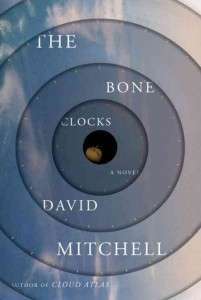The Bone Clocks
David Mitchell
Random House
Release Date: September 2, 2014
ISBN 978-1-4000-6567-7
Back in 2012 when I read David Mitchell’s Cloud Atlas, I was at first confused, then amazed, then delighted. It was unlike any other book I had read. Jumping around in time, sharing characters and talismans in ways oblique and complex, it defied genres and yet satisfied unlike anything else I had known. (Forget the movie that came after – there was no way cinema could capture the allure of the book and its convoluted yet unfolding story, even though it did its best.)
Now having read The Bone Clocks, which retains much of the kinetic structure of Cloud Atlas but in a more accessible and sequential manner, I am convinced that not only is Mr. Mitchell possessed of incredible acumen, but he is one of the most astute storytellers of our generation.
The Bone Clocks begins in 1984, when fifteen year old Holly Sykes leaves home after a fight with her working class mother over – what else? – a boy, or in this case a twenty-four year old manchild. She’s not really running away as much as asserting what she believes is her independence, but like much of life (which she has yet to learn) most intentions rarely unfold as planned. Her impetuous trek to “teach her mother a lesson” turns out to have unexplained consequences that we only get to piece together many years – and many other sequences – later.
In 1991 we meet Hugo Lamb, smarmy Cambridge student from a wealthy family, who is the epitome of an aristocratic rogue in the making; a young man who is not above playing his friends, his family, anyone he can benefit or take pleasure from as he suavely moves from one scheme to another, albeit without totally becoming bereft of style or substance – barely. In 2004 there is Ed Brubeck, glimpsed earlier and now fleshed out as a foreign correspondent in gritty, war-torn locales such as Bosnia, Rwanda, Sierra Leone; his section alternates between a family wedding in Sussex and harrowing experiences he encounters while following the trail of a story in Baghdad. In 2015 the narrative shifts to Crispin Hershey, literary snob and petty novelist who is struggling to remain relevant, although he has overreached his talent and worn out his welcome, not that he would ever admit it, especially to himself. In 2024, psychiatrist Iris Fenby begins to pull threads together as all the stories fall open in a pattern that is dazzling, archaic and yet fraught with heart pounding implications for civilization itself. And then on to 2043…
Each of these sections is gripping in and of itself; the characters are deep and compelling, even those that are not eminently likeable. Each section builds its own world, its own feel, its own sympathies and conflicts. As a reader, for much of the book you should sit back and ask, “why am I being taken here?” but honestly, you just don’t care because everything is so keenly written, so involving. Even the world of the near future is superbly realized, with just enough difference to give the sensation of time passing without glitz and hyperbole, differences snuck in not even as asides, but just as a part of life. Well, until the world truly has changed, but even then it feels so… possible (for good or ill).
Throughout it all, Holly – and what happened to her even before 1984 – remains a touchstone, although why is not apparent and to what extent ebbs and flows. But other characters, main and adjunct alike, float throughout the story, like blueberries being folded into muffin batter, swirled around, bobbing up, and leaving trails of influence in their wake. (There are even a few wonderful moments when characters from Cloud Atlas appear in The Bone Clocks, although being aware of them does nothing more than add to the atmosphere of the story, like a wink at an inside joke.)
Something else runs throughout the narrative – the sense that no matter how thorough the plan, there are factors that will provoke unintended consequences which have to be endured or overcome, regardless of fairness, regardless of motivation. In each section, immediate consequences must be dealt with, yes, but there are also more deeply embedded layers of hidden influences and subterfuges, gives and takes and forcements, of which many of the characters have no inkling. Yet while the immediate consequences impact the individual players, the consequences of the hidden layers threaten to completely upend not only the most solid of lives, but even the very fabric of the world. How each character responds to consequences both known and unknown is heart rending, or exhilarating, or tragic, or all of the above. And this has been crafted without preaching or moralizing or anything that smacks of overt sentimentalism.
This novel is, quite simply, a tour de force. Intelligent, complex, yet ultimately very human and very relatable (even at its most “other-worldly”), The Bone Clocks excels on so many levels that superlatives become inadequate. There are myriads of good, even wonderful books out there, but there are very few that, once I close the cover after the final page, I simply sit there in awe after uttering a single “whoa”, letting the experience sink in. I literally did that with this book.
I often talk about how Guy Gavriel Kay’s masterpiece Under Heaven is probably the most exquisite book I have ever read. The Bone Clocks is going up on the bookshelf right next to it. It simply is that good.

